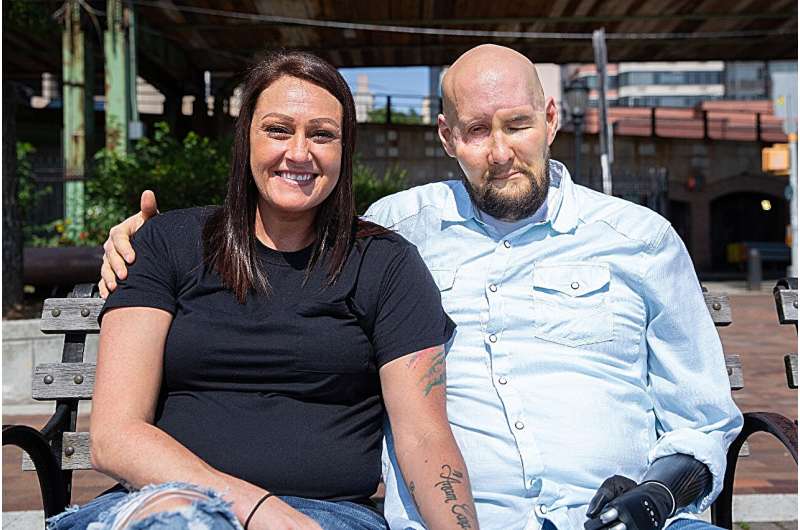This article has been reviewed according to Science X's editorial process and policies. Editors have highlighted the following attributes while ensuring the content's credibility:
fact-checked
peer-reviewed publication
reputable news agency
proofread
He's doing great a year after world's first eye and partial face transplant

The recipient of the world's first combined whole-eye and partial face transplant is doing well more than a year out from his groundbreaking surgery, NYU Langone doctors report.
Aaron James, a 46-year-old military veteran from Arkansas, says over the past year his new face has allowed him to enjoy things others take for granted.
No more stares from strangers. The ability to taste and enjoy solid foods again. The simple pleasure of smelling. Trading in his old driver's license, which displayed his injured face, for a new one.
James is now back to daily life in Arkansas and focused on sending his daughter, Allie, off to college.
"I'm pretty much back to being a normal guy, doing normal things," James said in an NYU Langone news release. "All in all, though, this has been the most transformative year of my life. I've been given the gift of a second chance, and I don't take a single moment for granted.
James was maimed in June 2021 when his face touched a live wire on the job as a high-voltage lineman in Arkansas.
The deadly 7,200-volt shock tore up his face. Even after multiple reconstructive surgeries, James still had extensive injuries that included the loss of his left eye, entire nose and lips, front teeth and chin down to the bone.
In a 21-hour surgery performed in May 2023, a NYU Langone Health surgical team transplanted an entire left eye and a portion of a face from a single donor onto James. The surgery involved a team of more than 140 surgeons, nurses and other health care professionals.
His doctors report on his progress in a paper published Sept. 9 in the Journal of the American Medical Association.
"Our discoveries over the past year mark promising initial results, laying a foundation for further advancements and ongoing research," said senior study author Dr. Eduardo Rodriguez, director of the Face Transplant Program and chair of plastic surgery at NYU Langone.
"We are truly amazed by Aaron's recovery, with no episodes of rejection," said Rodriguez, who led the surgical team for James' transplant. "Our methodical approach to the matching process, ensuring that Aaron received the most favorable donor match, along with our unique immunosuppression regimen, has set the standard for eliminating and avoiding early rejection episodes."
It's not gone perfectly. James' new left eye has not regained vision, his doctors report.
However, the transplanted eye has maintained normal pressure and blood flow over time, something that hasn't happened when whole eyes have been transplanted into lab animals, researchers said. In those experiments, the eye often shrank significantly.
Tests have revealed that James' transplanted eye is having an electrical response to light, indicating that the light-sensitive nerve cells in the eye survived the implant. This provides hope that future whole-eye transplants could one day restore sight, doctors said.
James' procedure included an attempt to prompt nerve regeneration in the left eye's optic nerve through an injection of stem cells. It doesn't appear to have worked, and noticeable damage to the optic nerve has resulted in the loss of some retinal tissue as the eye recovered.
"We've done the work to transplant an eye. We now need to do more work in understanding how to restore sight to the eye," Rodriguez said.
"The first challenge is successfully transplanting an entire eye into a new human and keeping that eye alive without rejection—a feat Dr. Rodriguez and the NYU Langone team have achieved," said Paul Glimcher, director of NYU Langone's Neuroscience Institute.
"The next hurdle is preserving the nerve cells in the eye during the transplant process, and in this case, it's remarkable that some parts of the retina have survived over the past year," Glimcher said. "The critical task ahead is to ensure that all of the eye cells survive the transplant, which is essential for restoring connections to the brain. That is the fundamental requirement for vision, as sight is primarily a function of the brain, not just the eyes."
In the meantime, James has been getting back to life as normal with his new face, which came from a donor in his 30s. The donor also saved three other people by donating his kidneys, liver and pancreas, according to New York organ procurement organization LiveOnNY.
This is the fifth face transplant performed under Rodriguez and the first known whole-eye transplant ever done, doctors said.
"I have felt honored to be patient zero," James said. "Even if I can't see out of my new eye, I've gained my quality of life back, and I know this is a step forward in the path to help future patients."
In the transplant surgery, the team transplanted the left eye socket, including the orbital bones, as well as the nose, left upper and lower eyelids, left eyebrow, upper and lower lips, and underlying skull, cheek, nasal and chin bone segments.
"The aesthetic outcomes and quality of life this procedure has provided to Aaron should not be overshadowed," said lead study author Dr. Daniel Ceradini, director of research and an associate professor in the NYU Langone Department of Plastic Surgery. "He has regained many elements of life he lost after the 2021 injury, and that's our ultimate goal."
More information: Daniel J. Ceradini et al, Combined Whole Eye and Face Transplant, JAMA (2024). DOI: 10.1001/jama.2024.12601
Copyright © 2024 HealthDay. All rights reserved.




















